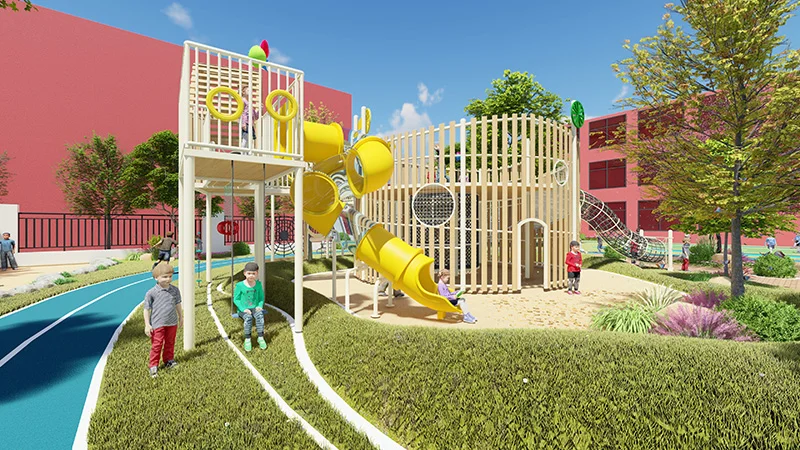Designing a natural, creative, power-free children's play environment requires consideration of a range of factors. Guangdong HEUO Industrial Co. Ltd’s play design has always followed the following 8 design rules to help us create an interesting and challenging children’s play space.
1. The design of unpowered children's play should strengthen the uniqueness of the site
After surveying the topography, determine the land parcels that can be utilized to create a unique scene. Understanding the topography and historical conditions of the site can help designers generate design inspiration. When designing a non-powered children's playground, it is very helpful to understand the spiritual connotation of the site or the style and overall atmosphere that needs to be reflected. This can also be used as the theme of the entire site. It can be a part of a building, a century-old tree, a historical allusion that happened here, an ancient sculpture, etc.

2. Site selection for unpowered children's playground
Most of the audience of unpowered children's parks are children, so they need to be very cautious in site selection. They should choose a venue where children can play freely and stay away from dangerous roads, noise, pollution, and harsh environments caused by force majeure factors.
3. Unpowered children's playgrounds should be close to the natural environment
Research shows that children benefit greatly from spending time in nature. Adding some more natural recreational facilities, such as green grassy slopes, trees and vegetation, signage, rockery boulders, etc., will make the playground more attractive.
4. The unpowered children's playground should be suitable for children to carry out various recreational activities.
A good unpowered children's playground can meet the needs of children of different ages and interests for recreational activities, and serves as an important social place for children, allowing children to have autonomy in play and encouraging them to use their imagination and creativity.

5. Unpowered children's playgrounds should be inclusive
A good non-powered children's playground should provide a venue for disabled children and able-bodied children to play together, bringing a happy activity experience. Although many playgrounds have special wheelchair access, it has to be admitted that many special needs of different types are involved and Not satisfied. Some non-specified equipment can be used flexibly, such as "mesh" swings. For many children with different needs and abilities, such non-prescriptive equipment can be very interesting.
6. Unpowered children's playgrounds should be loved by the community
A good unpowered children's playground should meet the needs of children and their community, allowing users to express their concerns, needs and wishes.
7. Unpowered children's playgrounds should meet the joint activity needs of children of different ages
Excellent unpowered children's playgrounds will not differentiate functions according to children's age and ability, but will meet the needs of children at a larger level in the planning and layout of amusement equipment and special facilities.

8. A non-powered children's playground should be a place where children can exert themselves and challenge themselves
Only through taking risks can children learn how to deal with risks. This is the essence of growth. "Play" has become the most important way for children to develop their abilities. Slides, climbs, and swings all have certain dangers. But if we set up various risk-avoidance facilities for children to exclude risks, it would be like wrapping children tightly with cotton wool to prevent them from being harmed.
Each unpowered children's playground is unique and requires custom design based on its location, target users and community needs. The play environment created through the above eight design methods can not only provide the play activities that children need, but also promote their growth and development, and help children grow up physically and mentally healthily.